Lighting for Art Galleries & Displays: A Buyer's Guide
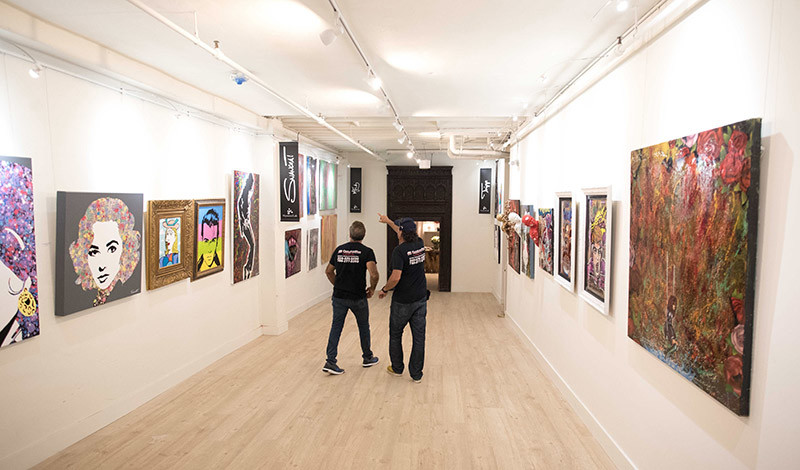
The Wynwood Labs display space in Miami uses a combination of ceiling-mounted track lights and an art hanging system with integrated lighting to provide outstanding art lighting. Note how the detail of each work is brought out with full, even illumination.
Lighting is essential to effective art displays. Clear, balanced illumination enables viewers to fully see and appreciate what’s going on in a piece of art, while shadows, glare, and distorted colors obscure the artist’s skill and presentation.
Choosing art lighting for art galleries or other display spaces can be confusing, given the many available options. Here are some tips on a strategic approach that can help you work through the art lighting alternatives.
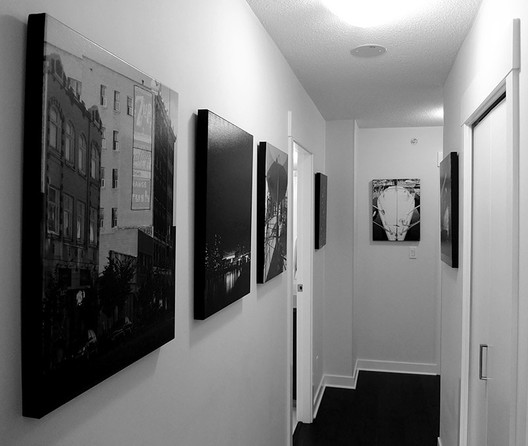
Here’s an example of how lighting can undermine the impact of works on display. The images on the wall at left suffer from glare at the top and shadows at the bottom; the person who posted this photo noted that he planned to add a ceiling track light to improve the situation. Photo by Reg Natarajan, used under Creative Commons
A good first question is, do you have a long-term relationship with your display space (e.g., ownership or extended lease), or are you apt to move on soon? This quickly determines whether electrical wiring and permanent fixtures could be a wise investment, or if the emphasis should be on art lighting equipment that can move with you.
Next, consider:
- How many works and/or walls do you need to illuminate?
- How many hours per day or week will the lighting need to be on?
- How often will your displays change?
Finally, keep in mind the quality of light – it significantly affects the appearance of the works being lit. Color temperature, the relative “warmness” or “coolness” of the light, is one key factor; warmer light can provide a richer appearance, while cooler, crisper light can reveal fine details. A related metric is Color Rendering Index (CRI), which measures how accurately colors appear under the light. Aim for a CRI of 90 or above. Also consider the shape of the beam – some bulbs cast a wide cone of light (flood-type) and some a narrower beam (spot-type), and it’s important that they match up well with the works you’re illuminating.
These factors loom especially large in lighting systems that do not have replaceable bulbs, like many of the newer LED-based fixtures. While manufacturer specifications offer some guidance, there’s no substitute for a firsthand test of the exact model you’re considering. Systems with replaceable standard bulbs offer much more flexibility going forward, including the ability to adapt to different types of displays and sizes and shapes of artworks.

This painting, in a Norwegian restaurant, is likely to remain in its perfectly sized spot for many years, and so is a good candidate for an individual picture light. Note, however, that the low ceiling has required the light fixture to be mounted in a spot that results in glare on the upper part of the painting. Photo by Helge Høifødt via Wikimedia Commons
Solutions for Short-Term Spaces
First, let’s look at options that are at least somewhat portable, and do not require electrical wiring or other modifications.
If you only need to light a small number of works, individual picture lights can be effective. These attach to picture frames or the wall above the work, with power supplied by household AC current or by batteries. Battery lights don’t have as much illuminating power but might be adequate if you only need occasional lighting (for parties, special events, etc.), and the works are relatively small.
AC-powered picture lights come in a wide range of shapes, sizes, and prices; for a short-term space choose the type that plugs in to a wall outlet rather than hard-wired models. Installation is relatively simple, but you’ll need to manage the cords in an aesthetically pleasing way and switch each unit on and off separately.
If you have more than a few works to light, need to adapt to exhibit changeovers, and can make a few discreet holes in the ceiling of your space, consider plug-in ceiling track light systems. These also require cord management, but each one typically provides 3 – 6 adjustable lighting heads that can be positioned for best advantage.
If your budget is especially tight and you’re working in a loft or other less-formal environment, you might be able to use inexpensive clamp-on utility lights, especially if there are exposed pipes or beams near the ceiling that they can clamp onto. While utilitarian in appearance, the lamps cost only a few dollars each, can accommodate a wide range of bulbs, and are nicely adjustable -- but be sure they are securely fastened in place and have plenty of airflow.
A high-quality alternative for short-term spaces, especially when many works and multiple exhibitions are involved, is an art hanging system with the option of gallery-grade integrated lighting, like Gallery System’s Original Gallery System. Once installed on the walls, this type of system eliminates wall damage from nails or hangers, while also providing light wands with top-quality bulbs that can be positioned at any desired location and adjusted to suit a wide range of works. And when it’s time to move on, everything can come with you for use in your next space.
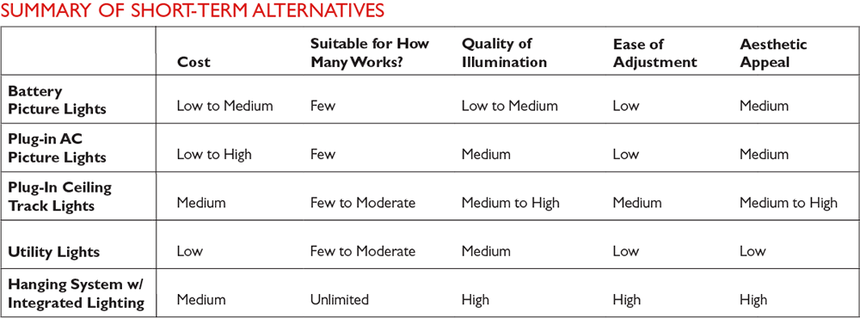
Permanent Installations Offer More Options
If you’re fortunate enough to be in your space for the long haul, a number of options open up.
As in short-term spaces, individual picture lights can work if you have only a few pieces that will not be swapped out. In a long-term situation, you can opt for hard-wired fixtures that draw power from wires hidden in the wall and can be controlled via a wall switch. An electrician’s services are needed, but the end result is sleek.
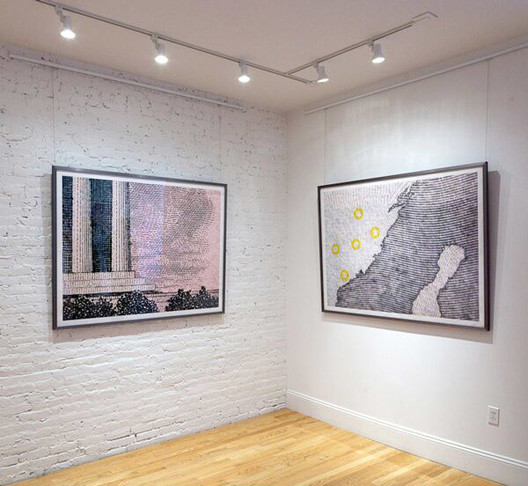
Many galleries use hard-wired ceiling-mounted track lighting; as shown here it can provide even, balanced illumination that brings out the nuances of the works on display.
If you’re planning regular exhibit changeovers with more than a handful of works, the traditional standard is hard-wired ceiling-mounted track lighting. With good reason – these track lights offer plenty of illuminating power, expandability, convenient control, no visible wiring, and the ability to freely move and aim the lighting heads. In addition, most systems use standard bulbs that are available in a variety of beam widths, color temperatures, and CRI values, so you get much more control going forward.
The downside is the need to invest not only in the equipment itself, but also in installation. An electrician’s services will be required, and walls and ceilings often need patching after the wiring goes in. Even a basic setup with 4 – 6 heads on an 8-foot track can end up costing $1000 once everything is finished.
Another hard-wired ceiling option is recessed can-type fixtures. They’re more discreet than track lights and can be equipped with a wide range of bulbs. While most offer some aiming ability, their fixed locations make them less flexible than track lights, and the per-light cost will likely be higher.
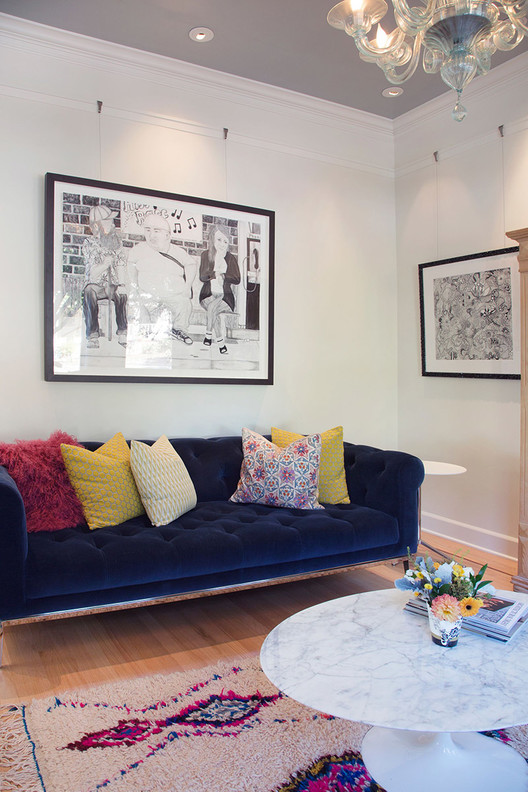
The ceiling-mounted “can”-type fixtures shown here have the advantage of being discreet and bright, but their adjustment range is limited. Note that two fixtures are lighting the work on the right; ideally the larger work on the left would also have a second light source. Photo by Margot Hartford
Again, if you’re displaying many works and your exhibits will change frequently, you’re already a good candidate for a Gallery System art hanging system, and the addition of lighting can provide excellent functionality at a relatively low incremental price increase. Per-light cost is on par with individual picture lights, and the Gallery Lighting Option light wands offer more-flexible positioning and interchangeable bulbs. They’re also easier to reach than ceiling-mounted fixtures and can often be adjusted from a stepstool rather than a ladder.
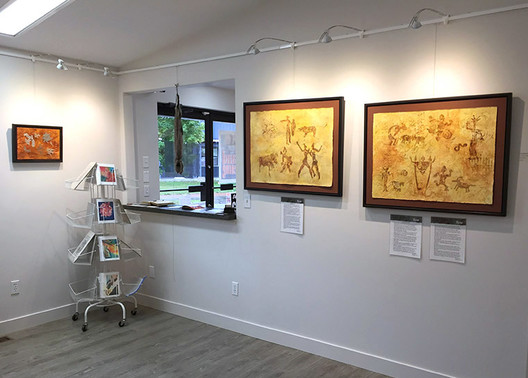
The Teyjah’s Art Den gallery in British Columbia uses an Original Gallery System art hanging system with integrated lighting to achieve warm, balanced illumination of owner Teyjah McAren’s petroglyph-inspired paintings. Note how the use of three light wands provides even coverage across two paintings.

We hope this overview has been helpful; if you still have questions, Gallery System representatives will gladly discuss your lighting project and exhibition goals. Call us at 800-460-8703, send an email, or use our convenient Contact Form.
And here are a few links to other useful art-lighting resources:
Hanging Basics: Lighting for Art Displays
Five Artwork Lighting Tips from Sotheby’s
How to Light Your Art Collection Like a Pro from ArtNet News
Gallery System's new Power Pack lighting option
